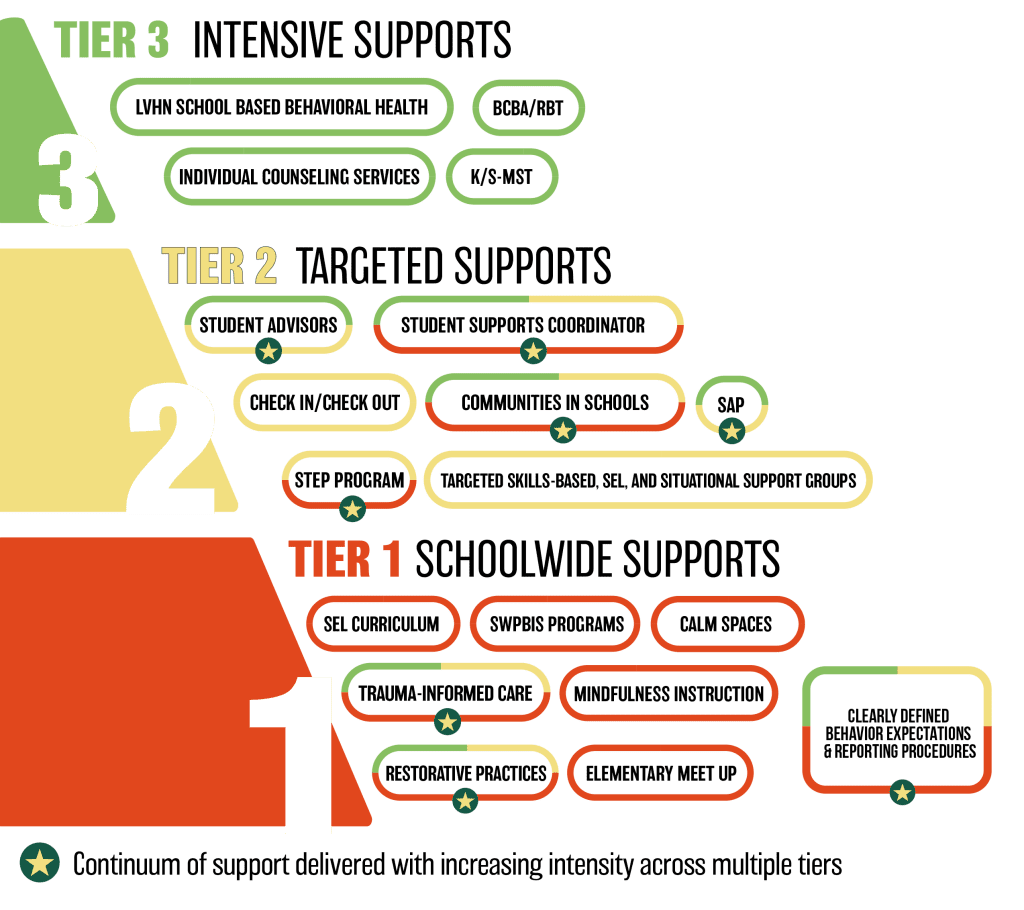What process does the district follow when receiving information regarding a potential immediate threat?
- Threats reported: Incidents are promptly reported to building or district administration.
- Immediate Police notification: Law enforcement is notified immediately by building or district administration.
- Immediate Central Office Administration notification: Central Office administrators are notified immediately by building or district administration.
- Police response: Law enforcement conducts a thorough investigation.
- Internal school-based investigation: School and district administrators conduct an internal investigation.
- Ongoing updates: Law enforcement provides updates to district administrators as the investigation continues.
- Credibility assessment: The threat is assessed for credibility, determining whether it is credible or non-credible.
- Communication Release: Once the credibility of the threat is confirmed or denied, the district releases parent and staff communication.
What does credible threat or non-credible threat mean?
A threat is a communication or behavior that indicates an individual poses a danger to the safety of school staff or students through acts of violence or other behavior that would cause harm to self or others. The threat may be expressed/ communicated behaviorally, orally, visually, in writing, electronically, or through any other means.
A credible threat means that a threat was made with the intent and the apparent ability to carry out the threat.
After an investigation, law enforcement deems a threat non-credible when through the course of the investigation, they find no legitimacy of the threat.
A social media threat refers to a message, statement, or post that is intended to evoke fear to an individual or group. We become aware that information is shared on social media and in many cases that information is inaccurate or is missing critical details. Although principals are limited in what they can share, we encourage our families to reach out to principals with questions instead of posting or reading social media posts by someone who is not a school district official responsible for communicating information.
Why doesn’t the district give specific information on the threat or the contents of the investigation in district communications or press releases?
The district must uphold the integrity of the investigation by refraining from communicating inaccurate information.
Why isn’t the student involved in the threat named? Since this is a minor, we do not have permission to release the student’s name. This would be a Family Educational Rights and Privacy Act (FERPA) violation. Under FERPA, all students have a right to privacy. There are very clear laws and guidelines regarding what information schools may share internally with faculty and staff, what information may be shared with law enforcement or any outside agencies, and what information may be shared with the community.
Why doesn’t the district communicate the consequences for students who make threats?
Since this is a minor, we do not have permission to release student discipline. This would be a violation of the Family Educational Rights and Privacy Act (FERPA).
US Department of Education-Protecting Student Privacy-Frequently Asked Questions
What is East Penn’s threat assessment process?
Threat assessment is a fact-based process for the assessment of and intervention with students whose behaviors may indicate a threat to the safety of the student, other students, school employees, school facilities, the community, or others.
East Penn has established a district-wide threat assessment program to ensure timely school-based threat assessment management in accordance with the Public School Codes of 1949, Article XII-E, Threat Assessment (Act 18 of 2019). The East Penn School District will use the Comprehensive School Threat Assessment Guidelines (CSTAG) as the Threat Assessment Model in all situations where a threat assessment is deemed necessary
Threat Assessment – A problem solving approach to violence prevention that involves both assessment and intervention with individuals who have threatened violence toward others.
Threat Assessment Team – A multidisciplinary unit within an individual school building or district that will direct, manage, and document the school entity’s threat assessment process. The Team is responsible for:
- Reporting and Identifying Threats
- Assessing and Classifying Threats
- Responding to and Managing Threats
Additional information about East Penn School District Threat Assessment Program can be found using the following link:
Information for School Staff, Parents and Guardians: Threat Assessment
Does the inclusion of the term MTSS and restorative mean consequences are not issued to students who violate our district discipline code?
Absolutely not. Students receive school discipline consequences in addition to notification of law enforcement and subsequent police charges for Level 4-6 offenses in the discipline code.
In order to help our families understand the concept of MTSS and Restorative practices, it is important to know the following:
Pennsylvania’s definition of Multi-Tiered System of Support (MTSS) is a standards-aligned, comprehensive school improvement FRAMEWORK for enhancing academic, behavioral and social-emotional outcomes for ALL students. The inclusion of the term MTSS in the context of discipline refers to a focus on behavioral outcomes.
Restorative practice seeks to examine the harmful impact of a discipline incident and then determines what can be done to repair that harm while holding the person who caused it accountable for his or her actions. Accountability for the offender means accepting responsibility and acting to repair the harm done when possible in addition to logical school consequences or legal consequences.
A restorative approach to school discipline is designed to empower students to learn from their behavioral challenges, understand the impact of their actions, and grow in their ability to make responsible decisions and problem solve. The East Penn School District is using Restorative Practices to build a sense of community by;
- Ensuring pathways exist to repair harm
- Brining individuals together impacted by school issues via shared dialogue
- Achieving a common understanding of school issues
- Coming to an agreement about responding the conflict and moving forward
Over the past several years, the district has increased many supports for students in regards to academics and behavior.

For more information, please visit our MTSS Behavioral Supports website.
